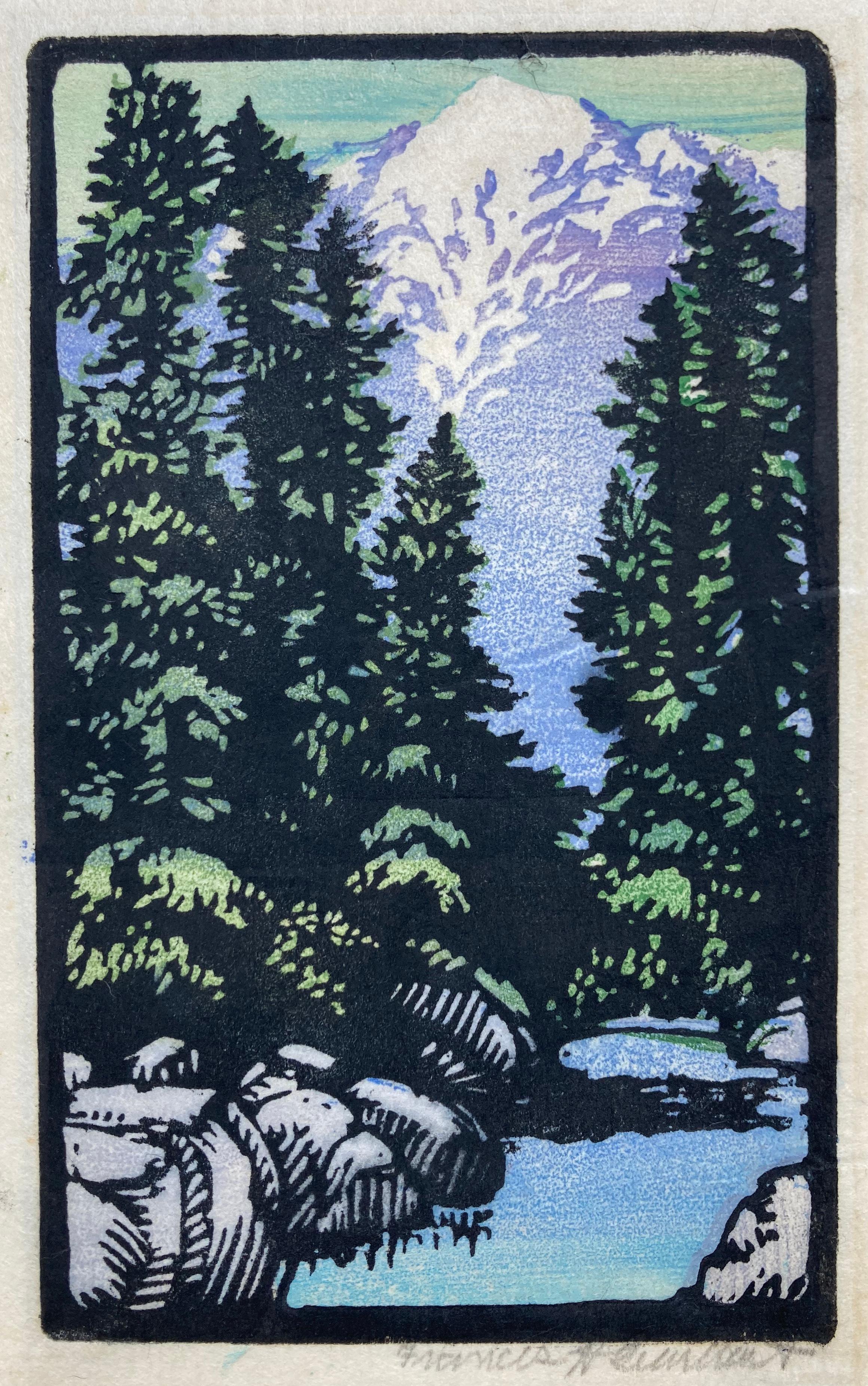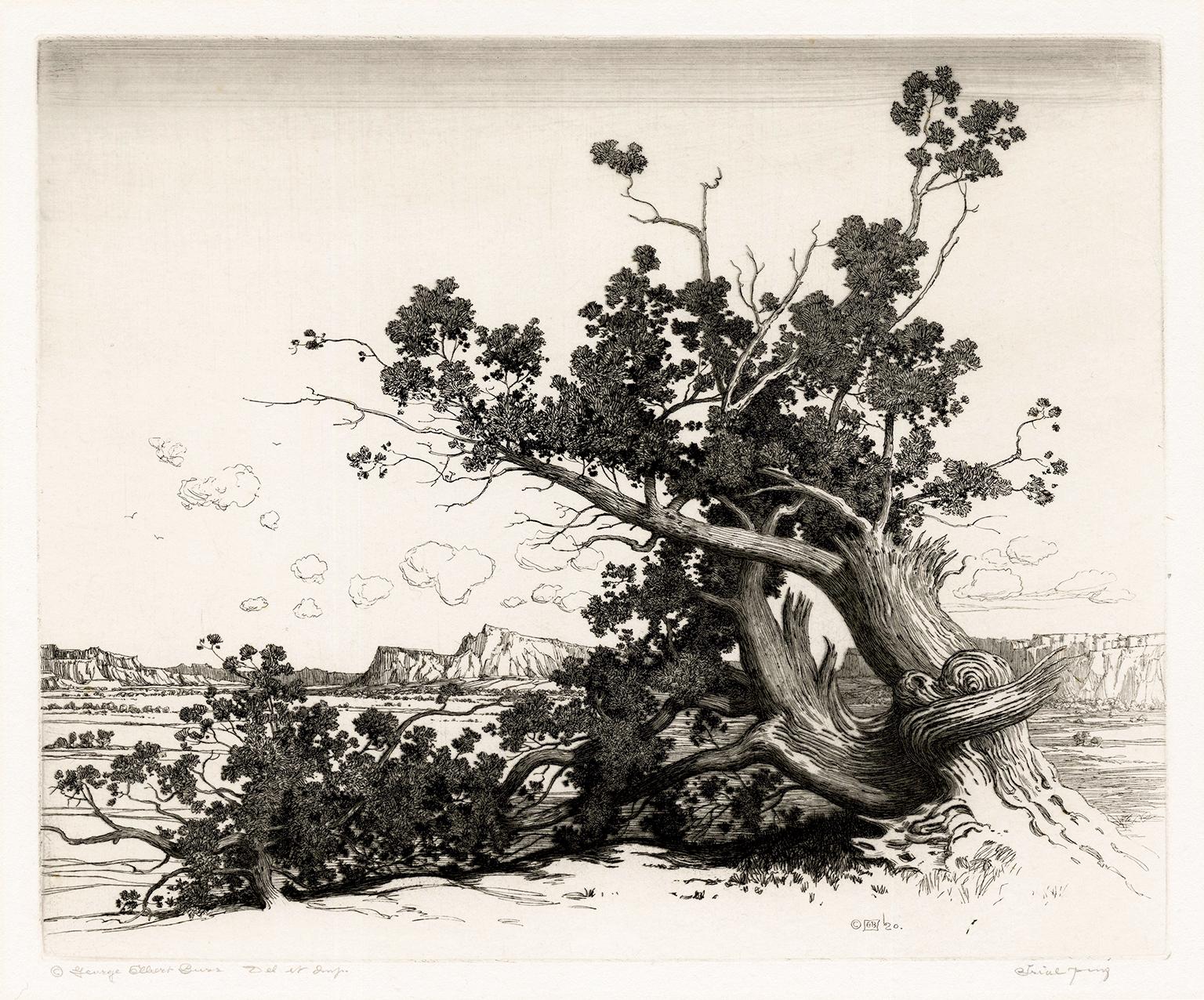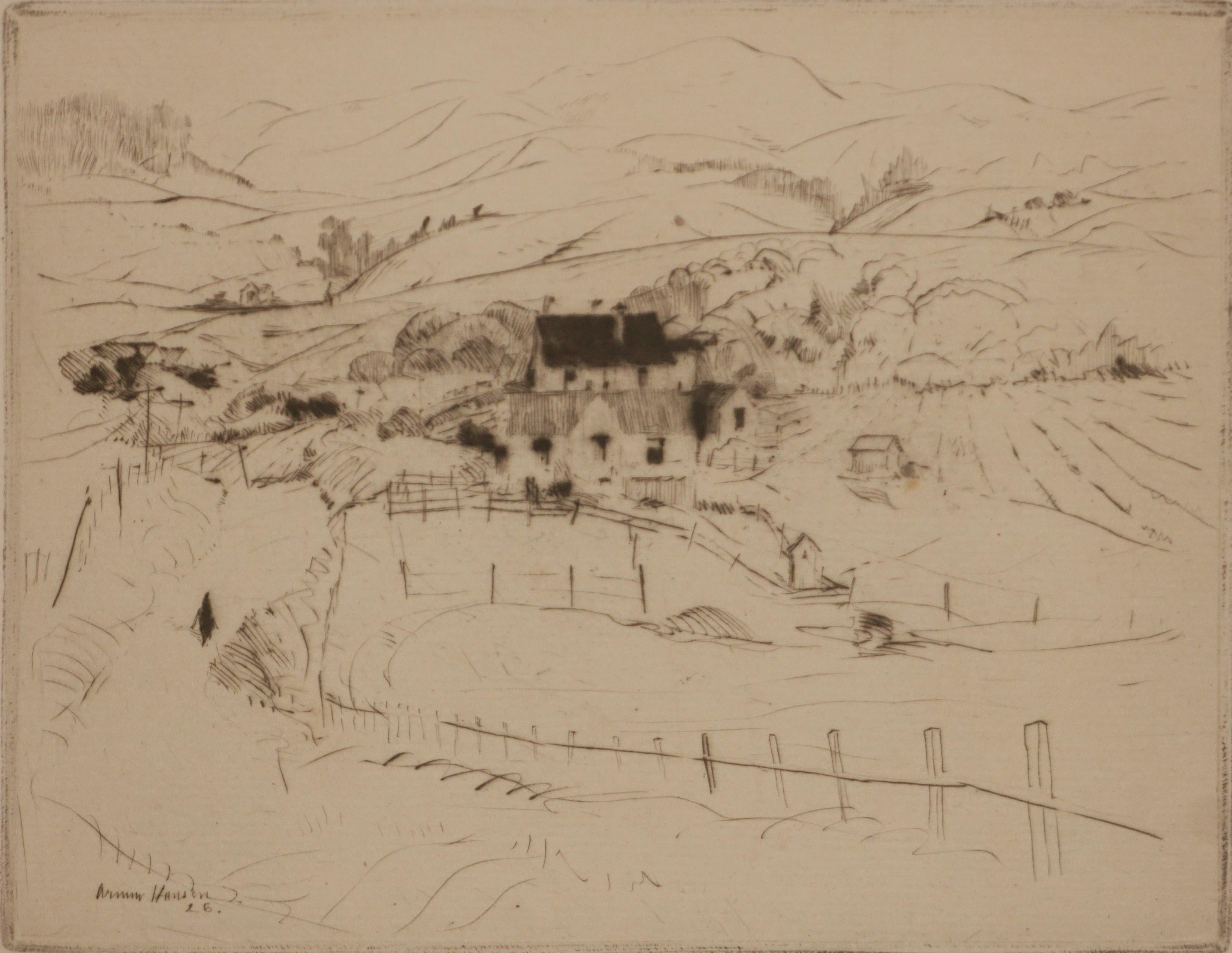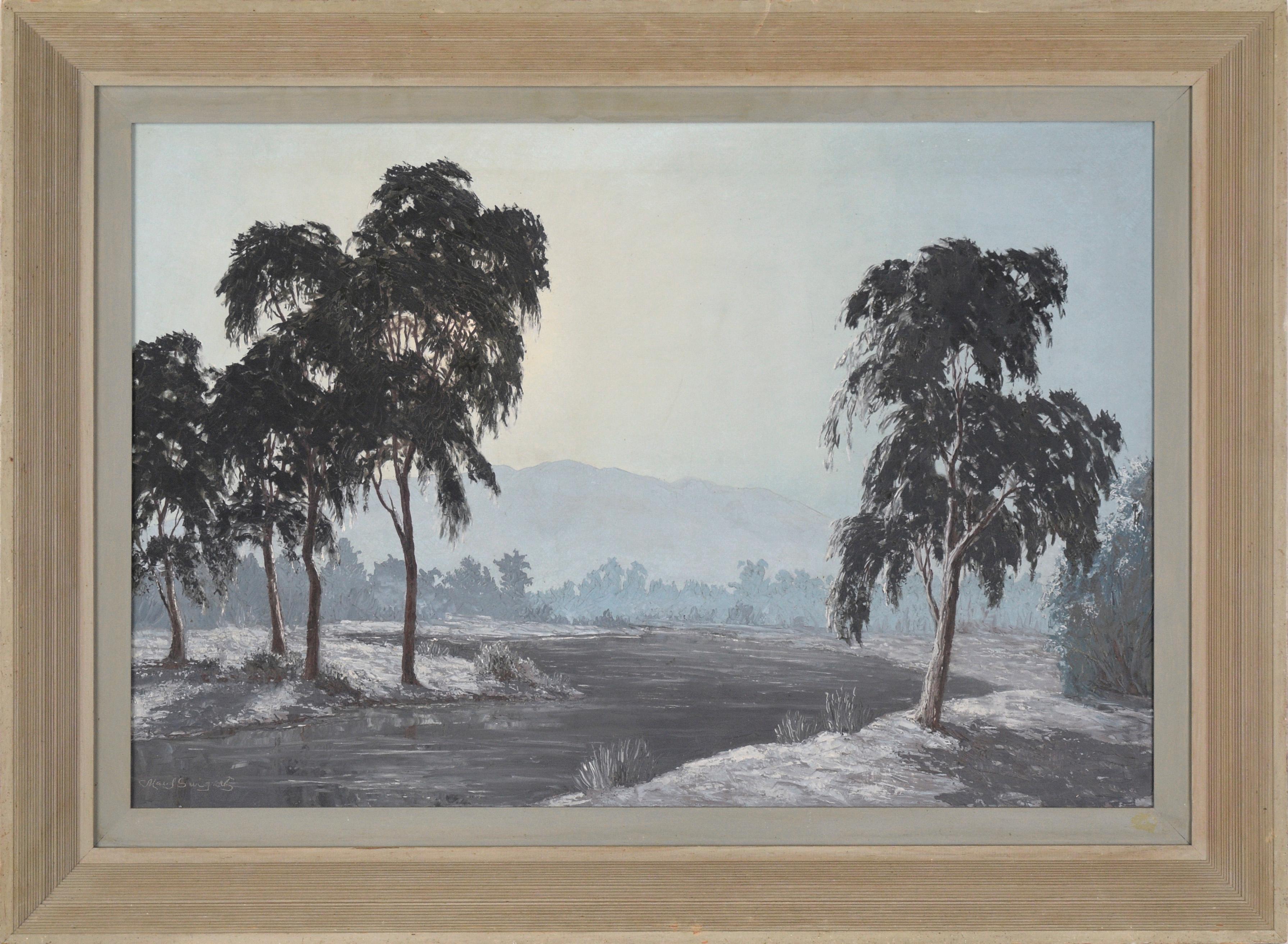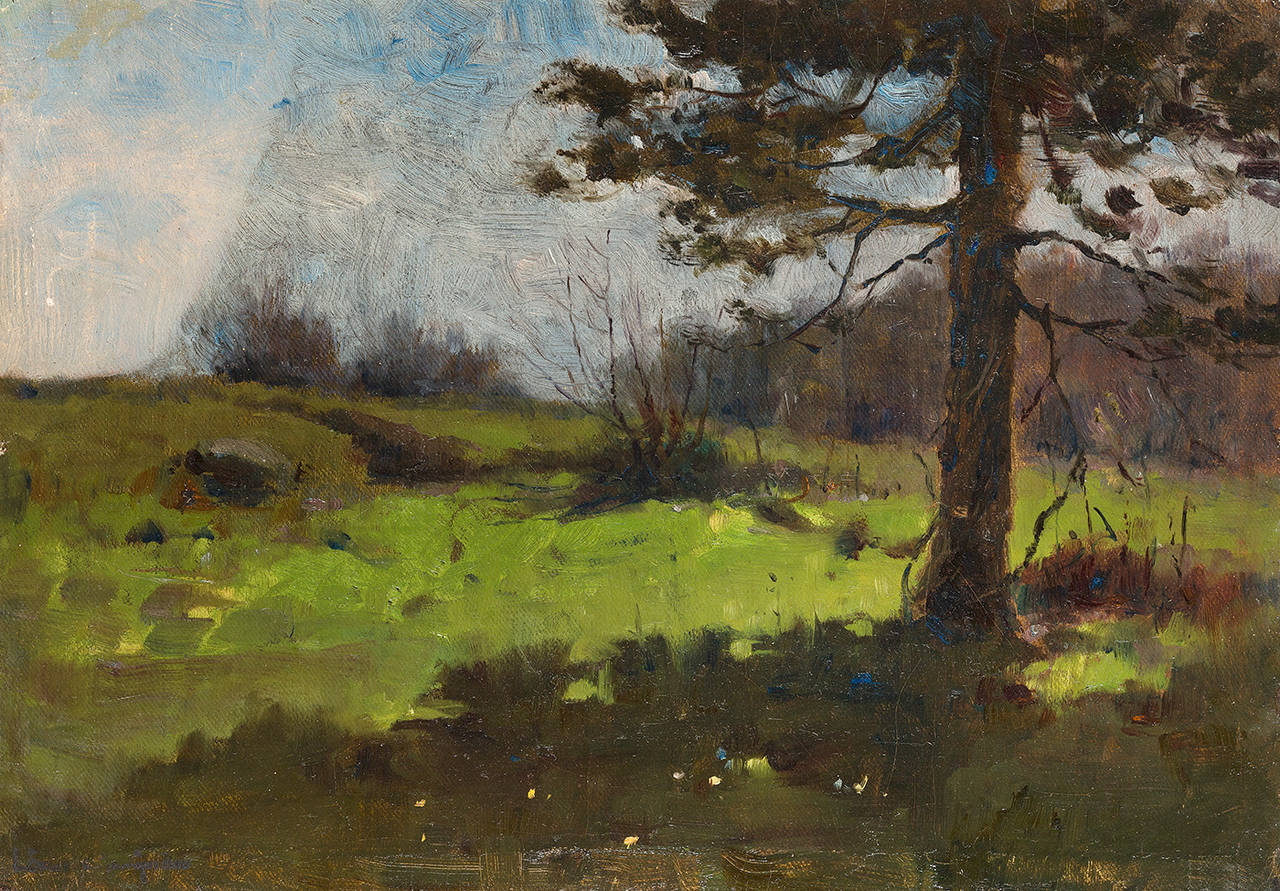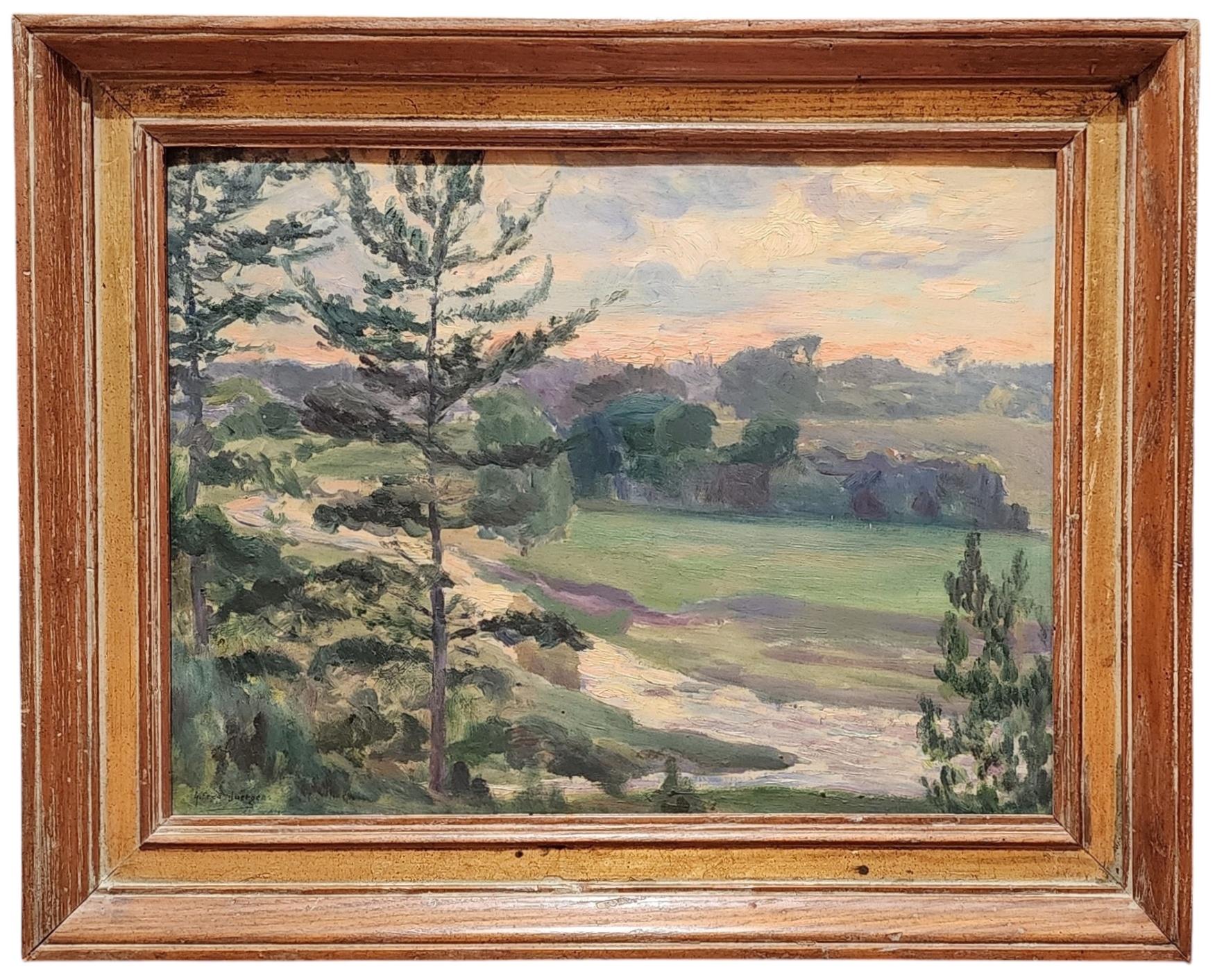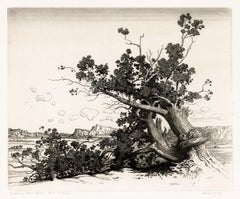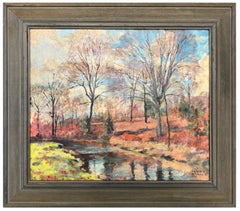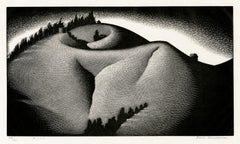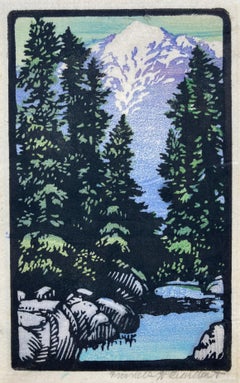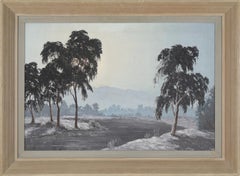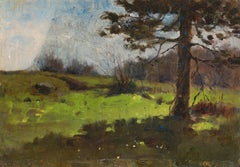Items Similar to 'Black Hawk Country' — Early 20th-Century American Impressionism
Want more images or videos?
Request additional images or videos from the seller
1 of 3
Ralph M. Pearson'Black Hawk Country' — Early 20th-Century American Impressionism1912
1912
$850
£641.13
€739.64
CA$1,199.80
A$1,335.90
CHF 695.18
MX$16,124.08
NOK 8,718.16
SEK 8,234.85
DKK 5,521.92
About the Item
Ralph M. Pearson, 'Black Hawk Country', etching, second state, edition not stated, 1912. Signed, and titled in pencil. Inscribed 'Rock River Series Second State'. A superb, richly-inked, atmospheric impression, in dark brown ink with selectively wiped plate tone, on cream wove Japan paper; the full sheet with margins (1 1/8 to 1 5/8 inches), in excellent condition. Matted to museum standards, unframed. Scarce.
Image size 8 7/8 x 13 13/16 inches); sheet size 11 5/8 x 16 3/4 inches.
Exhibited: 'Annual Exhibition of the Association of American Etchers', 1914.
Reproduced: 'Year Book of American Etching, 1914', John Lane Company, New York, 1914.
- Creator:Ralph M. Pearson (1883 - 1958)
- Creation Year:1912
- Dimensions:Height: 8.88 in (22.56 cm)Width: 13.82 in (35.11 cm)
- Medium:
- Movement & Style:
- Period:
- Condition:
- Gallery Location:Myrtle Beach, SC
- Reference Number:Seller: 971461stDibs: LU53237433362
About the Seller
5.0
Recognized Seller
These prestigious sellers are industry leaders and represent the highest echelon for item quality and design.
Platinum Seller
Premium sellers with a 4.7+ rating and 24-hour response times
Established in 1995
1stDibs seller since 2016
315 sales on 1stDibs
Typical response time: 1 hour
Associations
International Fine Print Dealers Association
- ShippingRetrieving quote...Shipping from: Myrtle Beach, SC
- Return Policy
Authenticity Guarantee
In the unlikely event there’s an issue with an item’s authenticity, contact us within 1 year for a full refund. DetailsMoney-Back Guarantee
If your item is not as described, is damaged in transit, or does not arrive, contact us within 7 days for a full refund. Details24-Hour Cancellation
You have a 24-hour grace period in which to reconsider your purchase, with no questions asked.Vetted Professional Sellers
Our world-class sellers must adhere to strict standards for service and quality, maintaining the integrity of our listings.Price-Match Guarantee
If you find that a seller listed the same item for a lower price elsewhere, we’ll match it.Trusted Global Delivery
Our best-in-class carrier network provides specialized shipping options worldwide, including custom delivery.More From This Seller
View All'Old Cedars' – Early New Mexico Landscape, Southwest Regionalism
By George Elbert Burr
Located in Myrtle Beach, SC
George Elbert Burr, 'Old Cedars – New Mexico', etching, 1920, edition 40, Seeber 218. Signed and annotated '(c) George Elbert Burr Del. et Imp.' in pencil. ...
Category
1920s Realist Landscape Prints
Materials
Etching
'Storm Clouds (Arizona)' — Early 20th-Century American Impressionism
By Albert Groll
Located in Myrtle Beach, SC
Albert Lorey Groll, 'Storm Clouds (Arizona)', graphite on paper, c. 1914. Signed in pencil, in the image, lower left. A fine spontaneous rendering on heavy buff, wove paper, with margins (1 1/2 to 2 inches); slight toning at the sheet edges, in good condition. With a pen and ink landscape drawing, verso.
Image size 7 5/8 x 10 inches; sheet size 10 3/4 x 13 5/8 inches. Matted to museum standards, unframed.
Provenance: Ex. collection Kennedy Galleries, New York.
ABOUT THE ARTIST
Albert Lorey Groll (1866-1910) was born in New York in 1866, the son of a pharmacist immigrant from Darmstadt, Germany. During his early years, he traveled to Europe to study at the Royal Academy of Fine Arts in Munich under Nicholas Gysis and Ludwig von Löfftz. He further pursued his studies in London and at the Royal Academy of Fine Arts in Antwerp, Belgium. Groll returned to New York in 1895 and moved from figure to landscape painting while expanding his interests to printmaking.
In 1904 Groll made the first of several trips to the American Southwest, traveling to Arizona with ethnographer Stewart Culin of the Brooklyn Museum. Later he went to New Mexico with his friend, the artist and illustrator William Robinson Leigh (see our 1stDibs listing no. LU53239015112 ). He focused on impressionistic scenes of Native American lands. The Laguna Pueblo people admired Groll's paintings, honoring him with the name "Chief Bald Head Eagle Eye."
Groll kept a studio in the Gainsborough Studios in Manhattan and won several awards for his work in Arizona and New York, including the Salmagundi Club Shaw Prize in 1904 and a gold medal at the Pennsylvania Academy of Fine Arts in 1906. He was also awarded the George Inness gold medal from the National Academy of Design in 1912 for his painting of Lake Louise in the Canadian Rockies.
In 1910 he was elected into the National Academy of Design and, in 1919, an associate member of the Taos Society...
Category
1910s American Impressionist Landscape Drawings and Watercolors
Materials
Pencil
Early Spring
By Arthur Ernest Becher
Located in Myrtle Beach, SC
Arthur Ernest Becher, 'Early Spring', oil, 1950. Signed and dated, lower right. A fine impressionist landscape, with fresh colors, on heavy illustration board, in very good, original condition, without inpainting. Framed in a period, 3 inch wide wood frame. Image size: 17 5/8 x 20 1/2 inches; outside frame dimensions: 23 3/4 x 26 5/8 inches.
ABOUT THE ARTIST
Arthur Ernst Becher was a painter and an illustrator of books and magazines. Born in Freiberg, Germany, he emigrated with his parents at the age of six to Milwaukee, Wisconsin. As a fine artist, he was known for his rural New York landscapes and historical scenes including Lincoln's Gettysburg Address.
He received early training from F.W. Heine and Robert Schade...
Category
Mid-20th Century American Impressionist Landscape Paintings
Materials
Oil
$1,280 Sale Price
20% Off
'Hill' — American Modernism, California
By Paul Landacre
Located in Myrtle Beach, SC
Paul Landacre, 'Hill', wood engraving, 1936, edition 60 (only 54 printed); only 2 impressions printed in a second edition of 150. Signed, titled, and numbered '49/60' in pencil. Wien...
Category
1930s American Modern Landscape Prints
Materials
Woodcut
Tranquil Harbor (Gloucester, Massachusetts) — 1950s Cape Ann Regionalism
By Lawrence Wilbur
Located in Myrtle Beach, SC
Lawrence Nelson Wilbur (1897-1988), 'Tranquil Harbor' (Gloucester, Massachusetts), wood engraving, edition 55, 1958. Signed in pencil, and signe...
Category
1950s American Modern Landscape Prints
Materials
Woodcut
Autumn Landscape — 1940s Post-Impressionism
Located in Myrtle Beach, SC
Henri Pierre Fortier, Untitled (Autumn Landscape), gouache, c. 1940s. Signed in ink. Inscribed 'To my Friend CLINTON R. MULFORD'. A fine, painterly watercolor, with rich, layered colors, on heavy dark brown drawing paper with approximately 1/4 inch margins; an unfinished figurative sketch...
Category
1940s Impressionist Landscape Paintings
Materials
Gouache
You May Also Like
SAN JACINTO
By Frances H. Gearhart
Located in Santa Monica, CA
FRANCES H. GEARHART (1869-1958)
(Mt.) SAN JACINTO c. 1926
Color block print. Signed in pencil. Unknown edition but uncommon. Image 6 5/8 x 4 1/8 inches. On Gearhart's typical fibrous japan paper. Sheet 10 ½ x 5 7/8 inches. Generally fresh with her usual pinholes along right margin for printing, slight bit of discoloration in the margins
Provenance: Whitmore - Print Corner, Hingham MA. Their Gearhart inventory no. They were Gearhart's principal East coast dealer in the 30's. Obtained from the Whitmore Collection’s grandson in 1995. Old Print Shop...
Category
1920s American Impressionist Landscape Prints
Materials
Woodcut
$3,700 Sale Price
22% Off
Early 20th Century Signed Etching By Armin Carl Hansen -- Valley Farm
By Armin Hansen
Located in Soquel, CA
Signed 1926 Armin Carl Hansen Etching and Drypoint of Central Coast California Valley Farm
Wonderful etching and drypoint of Valley Farm signed and titled by Armin Carl Hansen (Amer...
Category
1920s American Impressionist Landscape Prints
Materials
Laid Paper, Etching
$1,904 Sale Price
20% Off
Monochrome River Valley Landscape
Located in Soquel, CA
Tranquil desert valley landscape by Maud Swigert (American, 20th Century). A dark river cuts through the center of the composition, framed on either side by a white riverbank and dro...
Category
Mid-20th Century American Impressionist Landscape Paintings
Materials
Canvas, Oil
$975 Sale Price
35% Off
View from the Shade
By Luther E. Van Gorder
Located in New York, NY
Using what Sarah Burn’s calls the nineteenth-century artist’s “transformative power of personal vision,” Luther Emerson Van Gorder created brilliant impres...
Category
Late 19th Century Impressionist Landscape Paintings
Materials
Canvas, Oil
Indian Creek, Michigan Landscape, Chicago Artist, American Impressionist
By Alfred Juergens
Located in Grand Rapids, MI
Alfred Juergens (American, 1866 - 1934)
Signed: Alfred Juergens (Lower, Left)
" Indian Creek " (Michigan)
Oil on Board
14 1/2" x 19"
Housed in a 3...
Category
Early 20th Century American Impressionist Landscape Paintings
Materials
Oil, Board
$1,200 Sale Price
20% Off
Early 20th Century Plein Air Study for Homesteader Colorado Mountain Painting
By Frank Tenney Johnson
Located in Soquel, CA
Robert Azensky Fine Art is pleased to offer original 1909 sketch study of oil painting "Homesteader Colorado Mountain" painting by Frank Tenney Johnson.
It's always special to see the evolution of a painting through the plein air sketches ("studies") by the artist prior to its painting. Frank Tenney Johnson traveled throughout the Colorado Rockies sketching and painting western landscapes and native American and cowboy figurative art.
Medium: Charcoal on paper
Signature: Lower left corner
Date: "1909" below signature
Condition: Tonal aging and minor edge wear consistent with age and use. See images.
Presented in black painted wood frame
Mat size: 14"H x 11"W
Paper size: 9"H x 6"W
Image size (visible with mat): 8"H x 5.25"W
Frank Tenney Johnson was born in Coucil Bluffs, Iowa, in 1874 not far from the Overland Trail. During his childhood, he saw the steady stream of people heading west in all forms of horse-drawn conveyance. This early exposure to the American West was critical in leading Johnson towards the Western landscape as an inspiration for his work. The resulting body of work is a moody and romantic depiction of a long-gone America, rendered in a style that has become practically a genre all its own.
At the age of ten, Johnson moved from Iowa to Milwaukee, WI. There, he took an apprenticeship with F.W. Heinie, a prominent panoramic painter. After a year with Heinie, Johnson apprenticed for Richard Lorenz, a painter and former Texas Ranger who specialized in depictions of horses and western scenes. It was probably during his time with Lorenz that Johnson decided to focus on western subjects himself. He also started illustrating for regional papers and publications, in order to save money for further training.
Further training, as with many of the artists who populated New Mexico in the early twentieth century, took place at the Art Students League in New York, where Robert Henri, William Merritt Chase, John Twachtman, Kenneth Hayes Miller and F. Louis Mora were in the process of teaching perhaps the last great batch of pre-modernists. Though highly stimulated by the training, Johnson was only able to stay for five months, after which he returned to Milwaukee to work and save money in an effort to return to New York. He was able to do so after a time and, upon returning, established an important professional relationship with Emerson Hough, the editor of "Field & Stream" magazine.
At Hough's urging (and on Hough's dime), Johnson traveled to Hayden, Colorado, where he tagged along with a group of cowpunchers in order to sketch their way of life. Though primarily an artist, Johnson also wrote accounts of his time in Colorado for "Field & Stream." After Colorado came Cheyenne, Wyoming, where Johnson attended a "Frontier Days" celebration; after Wyoming, Johnson traveled to New Mexico, where he observed the Navajos and their threatened way of life. This trip changed Johnson from an academic artist with an appreciation for the west to a truly western artist.
Of particular interest to him, in stark contrast to other western artists of the time like Frederic Remington and C.M. Russell, were the more quotidian scenes of the West. Specifically, Johnson focused upon scenes featuring horses, especially at night. Johnson painted a great number of pieces that featured horses tied up outside of saloons, inns or trading posts for the night, the moonlit night punctuated by the warm glow from the lamps inside. In this, he can be considered a pioneer, as his night pieces still serve as the archetype for such work in western art.
Johnson became quite successful through his work for "Field & Stream." He was chosen to illustrate books by the prominent writer Zane Grey, and his gallery shows sold briskly. In fact, one particular show, at the Grand Central Art Galleries at the Biltmore Hotel in New York, sold out opening night. In fact, one man had bought out the entire show: Amon Carter. Having achieved financial security and comfort, Johnson followed his good friend Clyde Forsythe to Alhambra, CA, where the two established residency and shared a studio.
California treated Johnson well. He and Forsythe founded the gallery at the Los Angeles Biltmore...
Category
Early 1900s Hudson River School Landscape Paintings
Materials
Oil Crayon, Laid Paper
